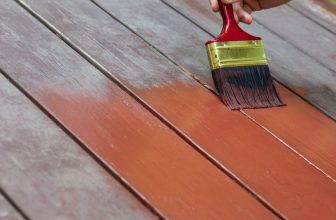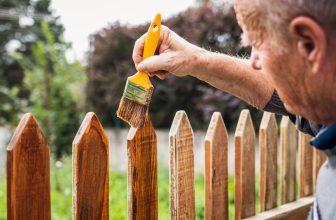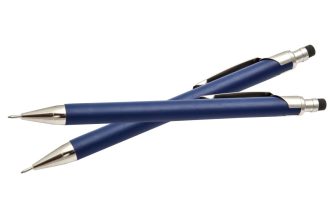Contents
If you’re buying pressure-treated wood, then you’ll likely know it’s a great material for exterior projects because of its longevity, strength, and resistance to degradation.
You’re most likely planning to use it for your deck, or some other outside building like a playset, or perhaps you just want to use wood that will stand the test of time.

Pressure-treated wood can constantly be exposed to the elements and still age well, without wearing down quickly or sustaining structural weakness.
Pressure-treated wood is made by treating wood with a variety of chemicals to make it more resistant. The problem is, this process leaves a green tint to the wood that looks ugly, and might appear to an observer like the wood has started to rot.
You can avoid this by staining the wood, which will not only make it look great but will also give it an added layer of protection to make sure your project will keep up for a long time.
Below, we’ve listed the best stains for pressure-treated wood to help you find the right product for you and your project.
This stain comes from Varathane, a premium and well-respected brand. They’ve earned that industry reputation for good reason, as this product is the perfect all-around best to suit most projects.
This is a major best-seller, and can be found on Amazon as well as most other online retailers,
This line comes in a variety of sizes depending on what suits your needs, with half-pint, pint, and quart tins available.
They also have a fantastic range of different colored stains available, some of which are really uncommon, and could be used to make some really unique-looking projects! In total, there are a whole 26 colors to choose from, so you’re sure to find the perfect one for you!
This stain has another unique feature in that, per its own instructions, it doesn’t have to be applied with a brush like a standard stain. Instead, you can use a clean cloth to rub the stain into the wood.
This will allow you to thoroughly cover the wood, and also help the stain get deeper into it. This is further helped by the stain being oil-based, making sure the stain will absorb far into the wood and help seal up any pores once it dries.
Lastly, it can’t be left out that the ‘fast-dry’ inclusion in the name isn’t an empty promise. A coat from this stain will dry in just 1 hour, about a third of the time it will take any standard commercial wood stain!
Also available at:
This product is great for a more low-maintenance solution to staining your pressure-treated wood. It allows you to color and protect it in one go quickly and easily.
There’s no need to use a primer, and can be reapplied without sanding off the previous coat, meaning you can re-stain any of your projects incredibly quickly.
This product also comes in a variety of 10 different colors, which are all classic looks, meaning you’ll almost certainly find the color that you want.
It can be applied either with a brush as standard or with a spray painter, as it comes in either a gallon or large 5-gallon buckets. Its formula sticks to the wood great, so you won’t get any odd-looking streaks or brush marks.
This stain is oil-based, so on top of great protection against water and moisture, it will also penetrate deep into the wood and ensure a complete stain that looks fantastic, the only downside being that it contains a lot of chemicals that might make you think twice about using it around pets or very young children.
Also Available at:
Perfect for the dense material of pressure-treated wood, this stain will still get a great finish on pretty much anything.
This stain applies easily and thoroughly, with only a single coat required to get a great stain that will protect your wood.
Composed of drying and non-drying oils, this will cure and protect the surface of your wood from harmful weather while also sinking into the wood and lubricating its inner structure to ensure your wood stays healthy for as long as possible.
This stain comes in either 1 or 5-gallon containers, and has a great color selection, with 17 different wood colors to choose from to ensure you’ll be happy with the end result.
They also come in 3 different versions, with semi-solid colors along with their transparent and semi-transparent range, meaning you have a lot of flexibility in your options.
Reapplication is also fairly simple with this, only needing to use a quick cleaner before reapplication. The only possible issue you might run into is overstaining the wood, as this is very potent stuff.
Make sure to only use a little and make it go a long way, otherwise, you’ll have a lot of stain sitting on the wood without being absorbed!
Also available at:
The Defy brand is extremely popular, and not without good reason. This stain is perfect for hardwoods that are pressure-treated.
It’s semi-transparent, which lets you see the natural grain of the wood while still giving a good colored hue and protecting it from the elements.
It’s also got a nice matte finish, making it perfect for use with decks as you’re less likely to slip on it than some of the shinier stains on the market.
Defy has some of the highest-quality resins on the market, and is highly resistant to fading over time. It will easily outlast competitors on the market by several months thanks to this, and keep your project looking great for a long time.
This also helps save you time and money, as you won’t find yourself needing to reapply the stain nearly as often. Even when you do, Defy makes it as easy as possible, only needing to use a wood brightener before applying a new coat to keep the perfect look.
This stain comes in 6 colors, enough for most people’s needs, and also has a clear variant for those that really want to keep the natural grain of the wood, though it may be too pale for your liking.
This stain is also water-based, making it environmentally friendly and a less toxic alternative to oil-based stains. It’s fortified with zinc to give it great protection against damaging UV rays, preventing graying and any color loss.
Also available at:
Storm provides high-quality and highly weather-protective oil-based stains for those in the harshest of climates.
Plus, it’s semi-transparent, which allows you to keep the nice grain of your wood while maximizing the protection and how long it will last.
This stain can be used on any type of wood, and applied with a brush, roller or spray can, but it’s intended for outdoor projects that will face heavy use, much like pressure-treated wood.
This is a long-lasting, deep-penetrating stain that offers incredible protection from UV rays and moisture, meaning the color will keep for a long time in pristine condition. There’s a variety of 6 classic wood colors to choose from, enough for most people’s needs.
It’s also easy to apply, simply mix and paint on in your preferred method, and leave it to dry for 24 hours before applying another coat if desired.
It absorbs into the wood quickly, giving you protection from the get-go and giving you great value for money as one of the longest-lasting stains on the market, able to last for as much as 3 years before needing reapplication.
Also available at:
Buyer’s Guide For Wood Stains For Pressure-Treated Wood
Check What Stain Base You’re Using
This is an important step you might overlook even if you’ve stained wood before. It’s not often an issue, but some woods are incompatible with certain stains, and you can cause more damage to the wood by applying a stain to it without thinking.
To know what kind of stain you should use for your wood, it’s always best to check what kind of stain you’re using first. There are four different types of stain solutions you’re likely to find in stores.
The majority of these will only be oil-based stains or water-based stains. You will sometimes see gel-based stains or varnish-based stains for more specialty projects.
Water-based stains are great if you’re looking for a more environmentally friendly and less toxic stain. They dry quickly, impart a lot of colors, and lubricate the wood well, preventing mold or mildew growth.
However, because of the high moisture content, it can cause rot in some woods that are more susceptible to it, so should be used with more rot-resistant woods.
Oil-based stains can penetrate deep into high-density wood and withstand wear better while also lasting longer and being less work to reapply. These are best used with outdoor projects and dense wood or pressure-treated wood.
Gel-based stains are, naturally, a lot thicker and quite easy to apply. Its thickness means it doesn’t get absorbed into the wood like other stains and instead sits on top, which means you should use it for woods that don’t drink in other stains very well.
They’re also quite useful for staining wood that’s vertical, as they won’t run down the surface of the wood.
Varnish-based stains are a clear protective finish. They don’t color the wood much and are often used as a topcoat for other stains. This is more for giving a reflective quality to your wood.
Be aware, though, it’s a very unforgiving stain to work with, and you have to be hyper-aware of wiping off any excess and avoiding any brush marks.
See How Much Coverage A Stain Has Before A Purchase
The amount of stain you purchase isn’t necessarily an indicator of how far it will go for you. Some wood stains have better coverage than others, meaning you can use less of it to get the same effect on your wood.
This is incredibly important to look out for when choosing a stain to purchase, as some high-quality stains will only use tiny amounts to stain large amounts of wood, while others may need a heavy lather that wastes time and money.
Remember, bigger isn’t always better!
Choose Eco-Friendly Stains Where Possible
It’s always best to be aware of the environment, partly for the sake of the planet and partly for the sake of your backyard!
Many stains, especially oil-based stains, can be very toxic and have a strong odor that sticks around long after the coat dries.
In the interest of your health and those around you, you should try and buy ecologically friendly stains that contain as few chemicals as possible.
Ideally, you’d use a water-based stain, but oil-based stains are generally better for outside projects and when using pressure-treated wood.
In this case, just keep an eye on the product descriptions to see if these stains are made using a lot of chemicals.
This is especially important if you’re working near or above grass or plants, as toxic chemicals from your stain can kill them if there’s any spillage.
Be Aware Of Coloring
Pressure-treated wood normally has a natural green tint because of the process it goes through.
This is disliked by many people because it looks similar to rotten wood, which may be why you’re staining the wood to begin with, but be aware that the green tint of the wood may affect the final coloring of the stain you’re using.
This will probably only be an issue if you are using stains other than oil-based stains, as they don’t permeate the wood as deeply.
If you’re unsure if the color will turn out the way you want it to, always check the type of stain. Darker colors tend to work better than lighter ones.
Frequently Asked Questions
What Type Of Stain Is Best For Pressure-Treated Wood?
Oil-based stains are always the best option for staining pressure-treated wood because it soaks into the dense wood better than other bases.
Is Staining Pressure-Treated Wood Different From Staining Normal Wood?
You stain pressure-treated wood the same way you would stain any other type of wood, per the instructions on the specific stain you’re using. You don’t have to worry about doing anything differently.
What Color Should I Stain Pressure-Treated Wood?
You can stain it any color you like. Be aware that lighter colors may not completely hide the natural green tint of pressure-treated wood, but as long as you are using an oil-based stain it should be fine.
If you don’t like the color at first, be sure to wait a few more days before considering removing the stain, as it can take some time for the color to soak into the wood.












